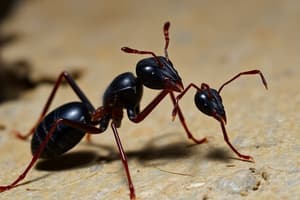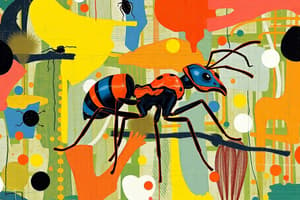Podcast
Questions and Answers
What is the primary reason Florida carpenter ants opt for wound cleaning over amputation when dealing with tibia injuries, according to the study?
What is the primary reason Florida carpenter ants opt for wound cleaning over amputation when dealing with tibia injuries, according to the study?
- The ants lack the dexterity required for precise amputation of the tibia.
- Tibia injuries are less painful, allowing for cleaning as a sufficient treatment.
- Insufficient muscle tissue in the tibia accelerates infection spread, making amputation too slow. (correct)
- Tibia injuries are inherently sterile, reducing the need for amputation.
What is the critical role of muscles in the context of amputation as performed by ants?
What is the critical role of muscles in the context of amputation as performed by ants?
- Muscles serve as a barrier to prevent pain during the amputation process.
- Muscles provide the force needed for the physical act of amputation.
- Muscles slow blood flow, giving ants time to perform amputation before infection spreads. (correct)
- Muscles facilitate the regeneration of lost limbs post-amputation.
How does Dr. Erik Frank characterize the ants' medical system in comparison to other known systems?
How does Dr. Erik Frank characterize the ants' medical system in comparison to other known systems?
- Ants' medical system is rudimentary, only effective against specific types of infections.
- Ants' medical system is comparable only to the human medical system in its diagnostic and treatment capabilities. (correct)
- Ants' medical system is advanced but requires external tools and resources.
- Ants' medical system is basic, relying solely on instinct rather than diagnosis.
According to the study, what is the immediate next step in the research regarding ant surgeries?
According to the study, what is the immediate next step in the research regarding ant surgeries?
Why is the presence of muscle tissue a determining factor in whether an ant will clean a wound versus amputate a limb?
Why is the presence of muscle tissue a determining factor in whether an ant will clean a wound versus amputate a limb?
Why is the observed 'surgical' behavior in Florida carpenter ants considered remarkable?
Why is the observed 'surgical' behavior in Florida carpenter ants considered remarkable?
What is the primary reason Florida carpenter ants amputate the legs of nestmates with femur injuries?
What is the primary reason Florida carpenter ants amputate the legs of nestmates with femur injuries?
How might the decision-making process of Florida carpenter ants regarding wound treatment be best described, based on the information?
How might the decision-making process of Florida carpenter ants regarding wound treatment be best described, based on the information?
What can be inferred about the role of social behavior in the survival of Florida carpenter ants, based on the study?
What can be inferred about the role of social behavior in the survival of Florida carpenter ants, based on the study?
How would the survival rates likely differ if the ants with tibia injuries were treated with amputation instead of cleaning?
How would the survival rates likely differ if the ants with tibia injuries were treated with amputation instead of cleaning?
If a new species of ant were discovered exhibiting similar injury-treatment behaviors, what additional factors would researchers likely investigate to understand this behavior fully?
If a new species of ant were discovered exhibiting similar injury-treatment behaviors, what additional factors would researchers likely investigate to understand this behavior fully?
Based on the text, how does the Florida carpenter ant's method of treating wounds compare to that of other ant species?
Based on the text, how does the Florida carpenter ant's method of treating wounds compare to that of other ant species?
What is hemolymph, and why is its flow relevant in the context of the Florida carpenter ants' injury treatment?
What is hemolymph, and why is its flow relevant in the context of the Florida carpenter ants' injury treatment?
Flashcards
Ants
Ants
Social insects known for teamwork, including building homes and finding food.
Florida Carpenter Ants
Florida Carpenter Ants
Ant species native to the southern United States, known for living in rotting wood.
Ant 'Surgery'
Ant 'Surgery'
Removing a limb to prevent the spread of infection.
Antimicrobial Substances
Antimicrobial Substances
Signup and view all the flashcards
Femur (in ants)
Femur (in ants)
Signup and view all the flashcards
Tibia (in ants)
Tibia (in ants)
Signup and view all the flashcards
Hemolymph
Hemolymph
Signup and view all the flashcards
Tibia Wound Treatment
Tibia Wound Treatment
Signup and view all the flashcards
Ant Muscle Function
Ant Muscle Function
Signup and view all the flashcards
Ant Tibia Infections
Ant Tibia Infections
Signup and view all the flashcards
Ant Wound Diagnosis
Ant Wound Diagnosis
Signup and view all the flashcards
Ant Amputation Purpose
Ant Amputation Purpose
Signup and view all the flashcards
Ant Wound Cleaning
Ant Wound Cleaning
Signup and view all the flashcards
Study Notes
- Florida carpenter ants exhibit remarkable social behavior by performing life-saving "surgeries" on injured nestmates.
- This behavior is unprecedented in non-human species.
- Florida carpenter ants are native to the southern United States, living in rotting wood.
- They often suffer injuries while defending their homes.
- Unlike other ant species, they lack antimicrobial substances.
- Dr. Erik Frank's team studied how these ants respond to battle-related injuries at the University of Würzburg.
- Researchers injured the legs of about 100 ants, creating cuts on the femur (upper leg) or tibia (lower leg).
- The wounds were exposed to a common soil germ.
- Injured ants were either left alone or placed back in their nests to observe treatment.
- Ant "doctors" cleaned each wound with their mouths.
Treatment of Femur Injuries
- Ants with femur injuries had their legs bitten off completely by other ants.
- Amputation took at least 40 minutes, involving multiple ants.
- This procedure led to a 90% survival rate among treated ants.
- Only 40% of isolated ants with femur injuries survived without treatment.
Treatment of Tibia Injuries
- Tibia wounds were treated with licking to remove bacteria.
- This resulted in a 75% survival rate for treated ants.
- Only 10% of the isolated ants with tibia injuries survived.
Decision Making
- Treatment depends on hemolymph flow, similar to blood in invertebrates.
- The femur has more muscle tissue, slowing down "blood" flow and bacterial spread, allowing time for amputation.
- The tibia has less muscle tissue, leading to faster infection spread, so ants clean the wound instead of amputating.
- According to Dr. Erik Frank the ants can diagnose a wound, determine if it's infected or sterile, and treat it, rivaling the human medical system.
- The findings were published in Current Biology on July 2, 2024.
- Future research will explore if other ant species perform similar "surgeries".
Studying That Suits You
Use AI to generate personalized quizzes and flashcards to suit your learning preferences.
Description
Florida carpenter ants perform life-saving "surgeries" on injured nestmates. This behavior is unprecedented in non-human species. Ant "doctors" cleaned each wound with their mouths. Ants with femur injuries had their legs bitten off completely by other ants.





